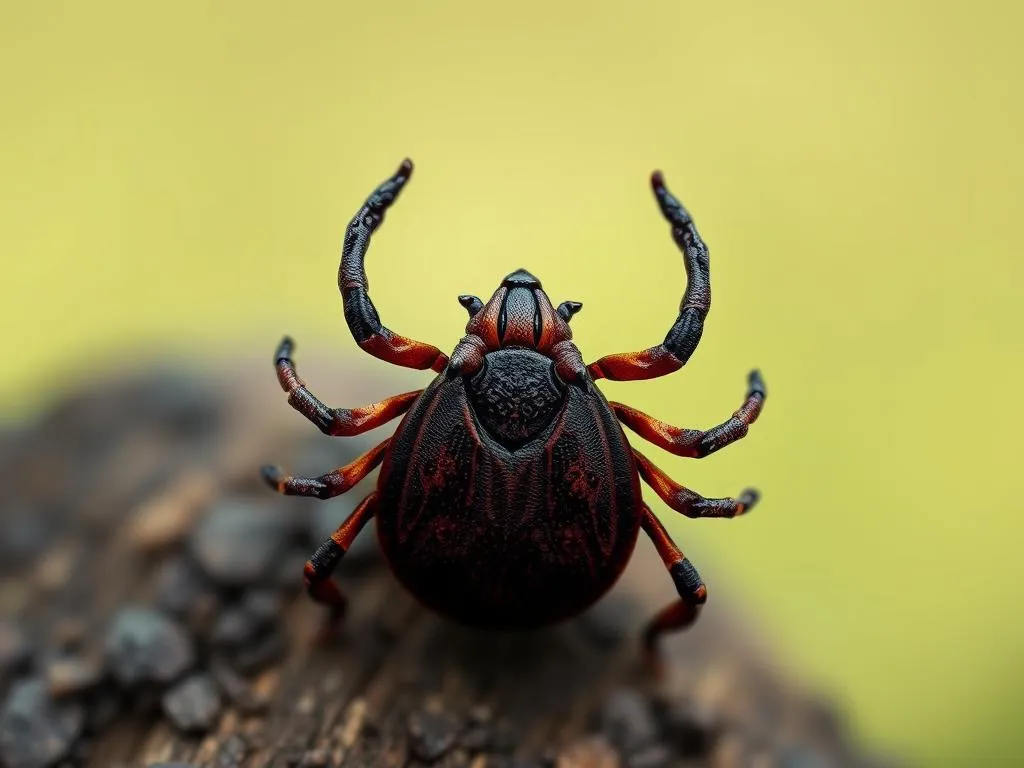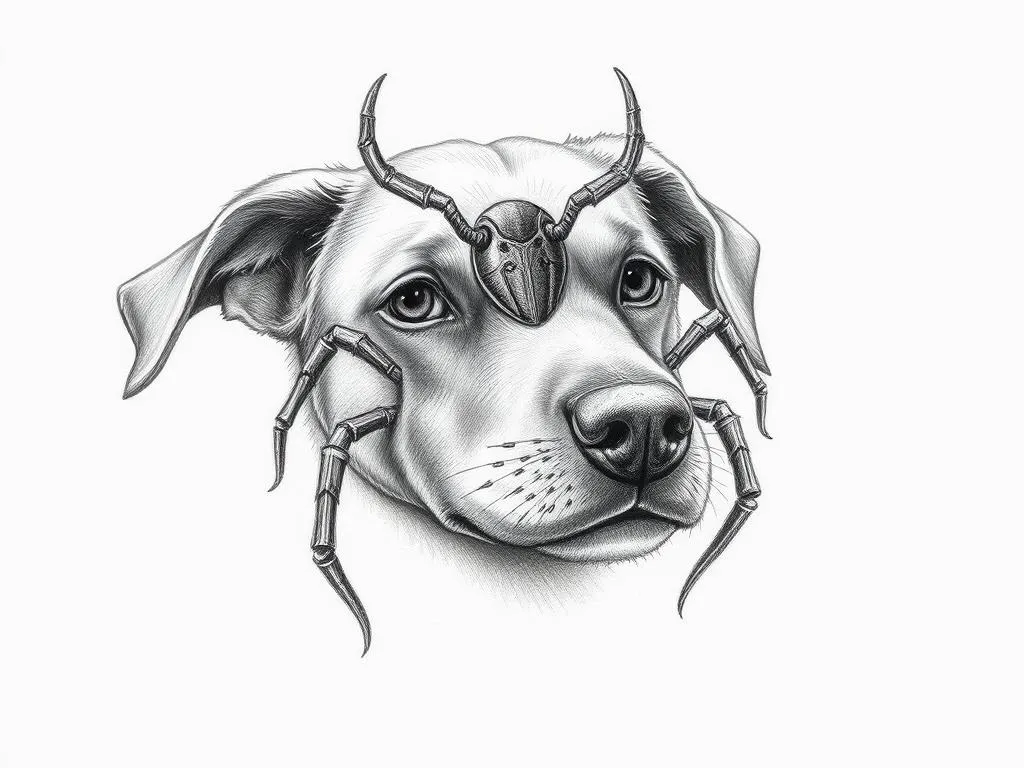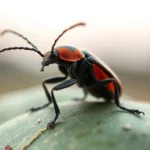Exploring the Symbolism of Dog Ticks

Disclaimer: Some images on this website are AI-generated artworks and may not accurately represent real animals.
The dog tick, scientifically known as Dermacentor variabilis, often evokes a sense of discomfort and concern. While many associate ticks primarily with health risks and parasitism, these small arachnids hold deeper meanings and symbols that can be explored. This article delves into the dog tick symbolism and meaning, shedding light on their anatomy, behavior, and the layers of significance they carry in human culture and personal reflection.
Understanding the Dog Tick
Before diving into the rich symbolism associated with dog ticks, it’s essential to understand their biology and ecological role.
Anatomy and Life Cycle
Dog ticks are fascinating creatures with distinct physical features. Here’s a quick overview of their anatomy:
| Feature | Description |
|---|---|
| Size | Typically ranges from 3 to 5 mm |
| Color | Brown to reddish-brown body |
| Mouthparts | Equipped with barbed structures for feeding |
| Body Structure | Flattened oval shape when unfed |
| Legs | Eight legs, characteristic of arachnids |
The life cycle of a dog tick consists of four stages: egg, larva, nymph, and adult. Each stage plays a vital role in their development.
- Eggs are laid in clusters, often in tall grass or leaf litter.
- Larvae emerge after a few weeks, seeking small hosts to feed on.
- Nymphs develop from larvae and require a blood meal before reaching adulthood.
- Adults can consume larger hosts, and females often feed multiple times before laying eggs.
Habitat and Behavior
Dog ticks thrive in various environments, typically favoring humid, wooded areas, tall grasses, and brushy fields. They are often found in regions populated by their preferred hosts, which include dogs, cats, and, occasionally, humans.
Feeding Habits and Host Preferences
These ticks are opportunistic feeders, attaching themselves to hosts for a blood meal. Their feeding behavior is crucial for their survival and reproduction. Once attached, they can remain on their host for several days, feeding on blood and potentially transmitting diseases.

Role in the Ecosystem
Dog ticks play an essential role in the ecosystem. They serve as food for various birds, mammals, and other predators, contributing to the food chain. However, their parasitic lifestyle can have significant impacts on wildlife and domestic animals, particularly when it comes to the transmission of tick-borne diseases.
Symbolism & Spiritual Meaning
While dog ticks may seem solely negative due to their parasitic nature, they also embody resilience and deeper spiritual meanings.
Resilience and Survival
Dog ticks exhibit remarkable resilience, adapting to various environments and climates. Their ability to thrive in challenging conditions serves as a powerful symbol of survival.
- Adaptations for Survival: Dog ticks can withstand extreme temperatures and prolonged periods without food, showcasing their tenacity.
- Thriving in Challenges: The persistence of these creatures can inspire us to embrace our struggles, reminding us that survival is often about adaptation.
Connection to Health and Disease
The association of dog ticks with health risks, particularly Lyme disease and other tick-borne illnesses, brings forth caution.
- Symbolizing Caution: Encountering a dog tick may symbolize the need for heightened awareness regarding health and well-being. It serves as a reminder to be vigilant about our surroundings and take proactive steps to maintain our health.
- Awareness in Health Matters: The presence of a tick can metaphorically indicate underlying health concerns, prompting individuals to reflect on their physical and mental well-being.
Attachment and Dependency
The parasitic nature of dog ticks also brings forth themes of attachment and dependency.
- Metaphor for Relationships: Just as a tick depends on its host for sustenance, some relationships can become one-sided, with one party taking more than they give.
- Exploring Themes of Dependence: This symbolism encourages introspection regarding our relationships, urging us to evaluate the balance of giving and receiving in our connections with others.
Dog Ticks in Dreams
Dreams involving dog ticks can hold profound meanings, often reflecting our subconscious fears and concerns.
Common Interpretations
Dreaming about dog ticks can symbolize various aspects of your life:
| Dream Element | Interpretation |
|---|---|
| Seeing a tick | Hidden fears or anxieties |
| Removing a tick | Releasing negative influences or relationships |
| Being bitten by a tick | Feeling overwhelmed or drained |
- Hidden Fears or Health Concerns: A dream featuring dog ticks may indicate that you are grappling with unresolved fears, particularly concerning health or personal relationships.
- Symbolizing Introspection: Such dreams can encourage personal reflection on attachment and dependency, prompting you to assess the dynamics of your waking life relationships.
Personal Reflection
Dog ticks in dreams can serve as powerful prompts for introspection.
- Encouraging Introspection: They challenge you to explore your feelings of attachment and dependency in relationships, urging you to identify any imbalances.
- Assessing Relationships and Personal Boundaries: Reflecting on these dreams can provide insights into your boundaries, helping you understand where you may need to assert yourself more or establish healthier connections.
Modern Interpretations
The symbolism of dog ticks extends beyond individual experiences to cultural perspectives and modern narratives.
Cultural Perspectives
Different cultures view ticks and their symbolism through varied lenses. In some cultures, ticks may symbolize resilience and survival, while in others, they are primarily seen as pests linked to disease.
- Duality of Role: This duality highlights the complexity of nature, where something perceived as a nuisance can also embody survival instincts.
- Cultural Significance: Understanding these cultural interpretations can deepen our appreciation for the roles that all creatures, including dog ticks, play in our world.
Influence in Popular Media
Ticks have made their way into literature and art, often representing broader themes of survival, fear, and dependency.
- Representation in Literature: Authors may use ticks as metaphors for hidden fears, burdens, or toxic relationships, reflecting societal concerns about health and well-being.
- Modern Narratives: Contemporary narratives often frame the symbolism of dog ticks in the context of environmental awareness and the interconnectedness of life, urging us to consider our place within the ecosystem.
Key Takeaways
As we explore the dog tick symbolism and meaning, several key themes emerge:
- Resilience: The adaptability of dog ticks reminds us of the importance of resilience in our lives.
- Health Awareness: Their association with diseases symbolizes the need for vigilance regarding our health and surroundings.
- Attachment: The parasitic nature of ticks encourages reflection on our relationships and the balance of giving and receiving.
- Introspection: Dreams involving dog ticks prompt us to assess our fears, boundaries, and attachments.
- Cultural Significance: The duality of ticks in various cultures highlights the complexity of nature’s creatures.
Conclusion
Understanding the symbolism of dog ticks opens the door to a deeper appreciation of their role in our lives and the environment. From resilience and health awareness to the intricate dynamics of relationships, dog ticks serve as powerful symbols worth reflecting upon. Embracing these themes can foster a greater understanding of our personal challenges and relationships, encouraging us to navigate life with both caution and resilience. As we reflect on the significance of these tiny creatures, we invite readers to consider their own lives through the lens of the lessons that dog ticks impart.







